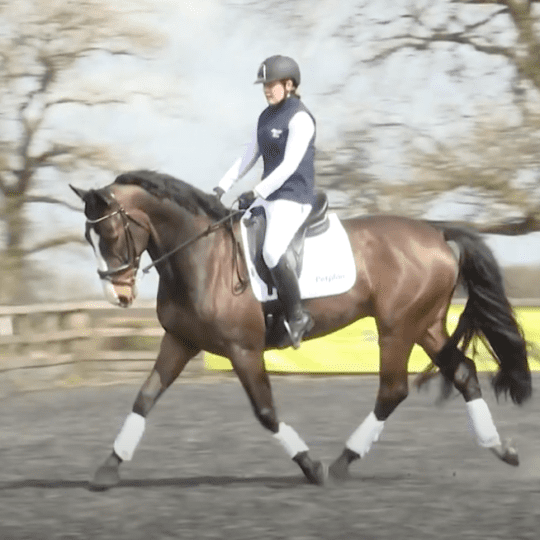Keep yourself safer in the saddle
Posted in Riding Schooling and Training Hacking Groundwork and Handling
Check out our top tips to help keep you more secure while you’re on board

Read his body language
Not all horses behave the same every day. Even one that’s usually sensible to hack may pop in a spook or a buck out of the blue.
Some mares can be unpredictable when they are in season, for example, or something could have happened that day to set the horses on edge, such as a hot air balloon flying over the field.
Read your horse’s body language so you can pre-empt any high jinks. If his ears are whirling like antennae and he’s turning his head to actively looking for something to be scared by, keep his attention and ride positively forward.
Anticipate he’ll leap sideways when you approach the ‘scary’ corner of the school, so you don’t become unseated, and maybe reconsider your plans to have a canter along the bridleway.
Plan his exercise
If your horse hasn’t been ridden for two weeks because of the lack of light or bad weather, is it any wonder you’re flat on your back in the school after attempting a jump. The problem can be exacerbated if your horse isn’t getting much turnout. Every horse is different and some need regular work. If you can’t ride, consider other ways of giving him exercise, such as lungeing or long-reining. Can you work flexible hours and leave work earlier one day a week, or is there a friend who can help exercise him when you are busy?
Assess his diet
If your horse receives too much energy from his food it can result in him being lively when ridden. Spooky behaviour or bucking can increase your chances of a fall. For many leisure horses in light and medium work, a high-fibre diet supplemented with a balancer or vitamins and minerals can be sufficient to meet his nutritional and energy needs.
Many owners fall into the trap of believing their horses need an increased amount of hard feed in winter. However, if you are riding less and feeding more, the horse will build up excess energy and could expend it in bucks and spooks when you are in the saddle.
You should always feed according to condition and workload and the best course of action is to consult a qualified equine nutritionist for advice.
Provide more turnout
Behaviour and ridden issues can occur when a horse is confined to a stable for long periods of time. Turnout time isn’t just about being given access to grass – the horse can stretch his legs, roll to relieve itches and enjoy some bonding time with his equine friends. Extra hours outside can help calm a horse, so he’s easier under saddle. However, even if a horse lives out they can still be lively when ridden, especially if they are confined to a small paddock which doesn’t allow them enough room to run and play.
Unfortunately, many yards restrict turnout in winter. If your horse has to be stabled more often, think of ways to enrich his time inside to stave off boredom, ensure he is exercised regularly, and consider moving to a yard where more turnout is available.
Spook-proof your horse
While you can’t prepare for every eventuality you might meet on a hack, you can cover a lot of the bases. Spend time desensitising your horse to plastic bags, flapping flags and dustbins in the safety of your arena.
You can do this yourself, or why not book an expert in spook-proofing to visit your yard and work with other horses as well? Should you experience a problem with something scary out on a hack, don’t risk a fall by trying to fight against your horse. If he is genuinely scared, stay calm and reassure him. A good option can be to dismount and lead him past whatever he’s worried about. If it’s safe to do so, you can remount or walk him back to the yard. Getting off is not admitting defeat, and the key thing is that you get back home in one piece.
Teach your horse manners
A polite horse that listens to his rider will make coping in difficult situations so much easier. Start on the ground, and ensure your horse is mannerly to lead and will stop and go when you ask him to. Teach him to stand still – he should wait patiently until you ask him to move. This relies on you staying calm and can take a bit of time to master, so don’t attempt it when you are in a rush or feeling stressed.
Start by asking him to stand for 30 seconds. If he moves a leg, gently ask him to return it to its starting position. Continue making the corrections and he will soon understand what is required. You can then build up to standing for one-minute, and increase this in stages to 10 minutes. It will take more than one session. Be consistent in what you ask your horse, and praise him when he does the right thing.
Apply an emergency stop
When a danger or hazard arises, you want your horse’s attention 100 per cent on you. Left to his own devices, his survival instinct of ‘flight’ could kick in. Teach your horse an emergency stop, which will be invaluable if something goes wrong. Begin in the school, with your horse in-hand. Give your horse a cue, such as ‘whoa’, ask him to halt and give him a treat. Work on this regularly on the ground or in the saddle, so the cue and response are firmly established.















